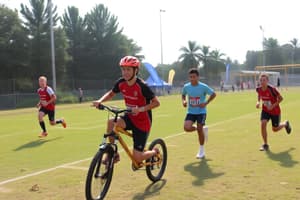Podcast
Questions and Answers
According to the LTD Model 3.0, at which levels do the 22 key factors operate to develop a rational, progressive long-term development framework?
According to the LTD Model 3.0, at which levels do the 22 key factors operate to develop a rational, progressive long-term development framework?
- The coach, the athlete's family, and the national governing body.
- The individual, each sport, and the Canadian system as a whole. (correct)
- The school system, the community programs, and the professional sports leagues.
- The training environment, the competition schedule, and the athlete's personal life.
Which of the following is NOT considered one of the '7 Personal Factors' influencing long-term development in sport and physical activity?
Which of the following is NOT considered one of the '7 Personal Factors' influencing long-term development in sport and physical activity?
- Sport-specific skill (correct)
- Predisposition
- Physical literacy
- Developmental age
Which of the following best describes how 'continuous improvement' is integrated into a Long-Term Development (LTD) framework?
Which of the following best describes how 'continuous improvement' is integrated into a Long-Term Development (LTD) framework?
- By ensuring that all athletes reach the same level of performance by a specific age.
- By strictly adhering to traditional coaching methods without adapting to new research or observations.
- By incorporating scientific innovations, ongoing education, and promoting integration between national sectors. (correct)
- By focusing solely on the physical development of athletes while neglecting psychological and social factors.
In the context of Long-Term Development (LTD), what is the primary emphasis during the 'FUNdamentals' stage?
In the context of Long-Term Development (LTD), what is the primary emphasis during the 'FUNdamentals' stage?
During the 'Train to Win' stage of Long-Term Development, what becomes the primary focus?
During the 'Train to Win' stage of Long-Term Development, what becomes the primary focus?
What is the recommended training to competition ratio during the 'Learning to Train' stage?
What is the recommended training to competition ratio during the 'Learning to Train' stage?
Elite athletes are focusing on what during talent refinement & optimization?
Elite athletes are focusing on what during talent refinement & optimization?
What are the main components of the Ideal Performance State (NCCP)?
What are the main components of the Ideal Performance State (NCCP)?
According to Gould & Maynard, what is a key factor in psychological preparation for high performance elite level athletes?
According to Gould & Maynard, what is a key factor in psychological preparation for high performance elite level athletes?
In Wooden's Pyramid of Success, what is the significance of 'Competitive Greatness' at the peak of the pyramid?
In Wooden's Pyramid of Success, what is the significance of 'Competitive Greatness' at the peak of the pyramid?
According to Tracey & Elcombe, what are the defining characteristics of 'Performance Optimizing' athletes based on elite level coach perspectives?
According to Tracey & Elcombe, what are the defining characteristics of 'Performance Optimizing' athletes based on elite level coach perspectives?
How does 'Mature Competitiveness' differ from 'Generic Competitiveness'?
How does 'Mature Competitiveness' differ from 'Generic Competitiveness'?
According to Tracey & Elcombe's additions to the NCCP Model, what is the significance of emphasizing 'sport view' and 'mature competitiveness' in athlete development?
According to Tracey & Elcombe's additions to the NCCP Model, what is the significance of emphasizing 'sport view' and 'mature competitiveness' in athlete development?
According to the recap of the LTD Model 3.0. which of the following is most accurate about the 'Active Start' stage?
According to the recap of the LTD Model 3.0. which of the following is most accurate about the 'Active Start' stage?
One of the organizational factors in the LTD model is 'periodization'. Which of the following describes periodization?
One of the organizational factors in the LTD model is 'periodization'. Which of the following describes periodization?
Which of the following choices represents LTD's '7 Systems Factors'?
Which of the following choices represents LTD's '7 Systems Factors'?
What does LTD stand for?
What does LTD stand for?
In Wooden's Pyramid of Success, which of the following factors are not explicitly mentioned?
In Wooden's Pyramid of Success, which of the following factors are not explicitly mentioned?
According to Tracey & Elcombe study on mature competitiveness, how did Coaches identify athletes to be?
According to Tracey & Elcombe study on mature competitiveness, how did Coaches identify athletes to be?
Flashcards
What is LTD Model 3.0?
What is LTD Model 3.0?
A long-term athlete development model with 22 key factors operating at three levels: the individual, the sport's organization, and the Canadian system.
Personal Factors in LTD?
Personal Factors in LTD?
The seven factors that influence individual athlete development: physical literacy, quality environments, developmental age, sensitive periods, predisposition, excellence taking time, and being active for life.
Organizational Factors in LTD?
Organizational Factors in LTD?
The eight factors within a sport organization awareness, first involvement, different activities framework, fully embedded appropriate specialization, periodization, competition and transitions.
System Factors in LTD?
System Factors in LTD?
Signup and view all the flashcards
Continuous Improvement Importance?
Continuous Improvement Importance?
Signup and view all the flashcards
Long Term Development Stages?
Long Term Development Stages?
Signup and view all the flashcards
What is 'Training to Win'?
What is 'Training to Win'?
Signup and view all the flashcards
What is the 'Ideal Performance State'?
What is the 'Ideal Performance State'?
Signup and view all the flashcards
Psychological Factors: Olympic Level?
Psychological Factors: Olympic Level?
Signup and view all the flashcards
Mature Competitiveness?
Mature Competitiveness?
Signup and view all the flashcards
Performance Optimization Model?
Performance Optimization Model?
Signup and view all the flashcards
What is 'Generic' Competitiveness?
What is 'Generic' Competitiveness?
Signup and view all the flashcards
Study Notes
- KP 200 is the course name for week #11.
LTD Model 3.0
- 22 key factors influence long-term development in sport and physical activity.
- Developing a rational, progressive long-term development framework with 22 key factors operating at three levels:
- The Individual (7 Personal Factors)
- Each sport and physical activity supporting organization (8 Organizational Factors)
- Across the Canadian system as a whole (7 System Factors)
The 7 Personal Factors
- Physical literacy
- Quality Environments
- Developmental age
- Sensitive periods
- Predisposition
- Excellence taking time
- For life
The 8 Organizational Factors
- Framework
- Fully embedded
- Awareness and first involvement
- Different activities, including high acrobatic, kinesthetic, common, and late specialization and transfer activities
- Appropriate specialization
- Periodization
- Competition
- Transitions
The 7 System Factors
- Collaboration
- System alignment
- Safe and welcoming environments
- Diversification
- Long-term development
- Continuous improvement
- Evidence-based practices
Continuous Improvement
- The Long-Term Development framework is based on the principle of continuous improvement
- The framework incorporates scientific, coaching, and sport-specific innovations and observations and is subject to continuous research.
- Continuously evolving mechanism for change to enable optimal participation in quality sport and physical activity for every child, youth, and adult.
- Promotes ongoing education, inclusion, and sensitization for all stakeholders at all levels.
- Promotes integration between national sectors based on common principles and shared goals.
- Research supports Long-Term Athlete Development (LTAD).
Long Term Development (LTD) in Sport & Physical Activity Model 3.0
- A model based on developmental age including:
- Active Start.
- FUNdamentals.
- Learn to Train.
- Train to Train.
- Train to Compete.
- Train to Win.
- Active for Life as the final stage, broken into two phases: Competitive for Life and Fit for Life.
- Developing physical literacy and building a solid foundation are key for stages 1-3.
- Training to Train and Train to Compete are the two most important stages for athlete development.
- Excellence is achieved through the Podium Pathway.
Training to Win
- Ages are sport-specific, at an optimal level for national and international development and competition at the highest levels.
- Focus on maintenance and incremental/marginal gains of physical, technical, tactical, and mental development.
- Maximize ancillary capacities with support from knowledgeable professionals and specialists.
- Frequent preventative breaks are important.
- Single or multiple periodization with focus on the most important competitions.
- Model all aspects of competition in training.
- Sport-specific technical/tactical/fitness training occurs 9-15 times per week, year-round.
- This is the final stage of athletic preparation (high-performance specialization) leading to optimal performance on demand.
Recap LTD Model 3.0 Competition/Calendar Planning
- Active Start has no specific ratios
- Fundamentals has no specific ratios and all activity is fun based
- Learning to Train consists of 70% training and 30% competing
- Training to Train consists of 60% training and 40% competing
- Training to Compete consists of 40% training and 60% competing
- Training to Win consists of 30% training and 70% competing, with actual competition and competition-specific training
- Active for Life is based on the individual's desire.
Talent Refinement & Optimization
- At very high levels of competition, times, scores, etc., can become so close among competitors that it is integral to focus on every possible aspect of performance enhancement.
- Key example: Olympic Winning Gold 100m Sprint Times.
Ideal Performance State (NCCP)
- Consists of four components:
- Tactical
- Technical
- Mental
- Physical
Psychological Preparation for the Olympic Games (Gould & Maynard)
- Mental preparation is important to enhance focus, attention, and performance.
- The Gould & Maynard review article has interesting findings regarding high-performance elite-level athletes.
- Key factors for psychological preparation:
- '+' self-talk is key, along with other common factors like mental toughness to block out distractions and increase the ability to control anxiety.
- Roles of parents, coaches, and other support systems and how they are similar for highly successful athletes.
- Stress and Coping.
Competitiveness and Performance: Wooden's Pyramid of Success
- The pyramid consists of mental and physical characteristics needed for success.
- Success is peace of mind, which is a direct result of self-satisfaction in knowing you did your best to become the best that you are capable of becoming.
- The foundation consists of Industriousness, Friendship, Loyalty, Cooperation, and Enthusiasm.
- The second tier consists of Self-Control, Alertness, Initiative, and Intentness.
- The third tier consists of Condition, Skill, and Team Spirit.
- The fourth consists of Poise and Confidence, leading to Competitive Greatness at the peak.
Performance Optimization (Tracey & Elcombe)
- Distinguishing factors exist between successful and unsuccessful athletes.
- A profile of "Performance Optimizing" athletes is based on elite-level coach perspectives.
- Characteristics of Performance Optimizing athletes:
- Rational approach to training/performance.
- Sustained passion/commitment to details.
- Ownership of the athletic experience.
- Embrace challenge/complexity of elite sport.
- See the big (moral) picture of sport/life.
- This leads to Mature Competitiveness.
Mature Competitiveness (Tracey & Elcombe)
- "Generic" Competitiveness involves passion, confidence, will, and the desire to win or succeed by doing anything during competition.
- "Mature" Competitiveness is different from everyone else and other athletes.
- Mature Competitiveness characteristics:
- A commitment to little things and taking ownership of performance every day.
- Recognizing the intellectual, physical, emotional, and ethical complexity of high-performance sport. Prepared to succeed in non-ideal situations, comfort with uncertainty, and seek out optimal challenges.
- Mature Competitiveness is very hard to achieve and maintain.
- A study identified athletes: 5% mature competitive, 20% generic competitive, and 75% non-competitive (at such a high level of athletics).
- An inherent starting point exists, but "mature competitiveness" can be developed over time.
Performance Optimization Model for Ideal Performance State (IPS)
- This model adds a concept to the NCCP model.
- Components:
- Tactical
- Technical
- Mental
- Physical including Sport View and Competitiveness
Reminders & Updates
- Assignment 3 is posted with an April 4th due date.
- It is an individual assignment.
- It has diverse parts (A-D) to suit everyone.
- BoT starts tomorrow.
- Sign-up sheets are available.
- Everyone does at least one event.
- Class Evaluations are next week.
- The Final Exam will be mostly multiple choice.
- There may be some short answer questions and possibly one long answer question.
Performance Grades
- Marks are out of 8 from the tutorial instructor/TA, which counts towards a performance grade.
- Each unexcused absence from designated tutorial sessions will result in an automatic 2-mark deduction from the student's final Performance Grade.
- Performance grades are final and non-negotiable.
Studying That Suits You
Use AI to generate personalized quizzes and flashcards to suit your learning preferences.




